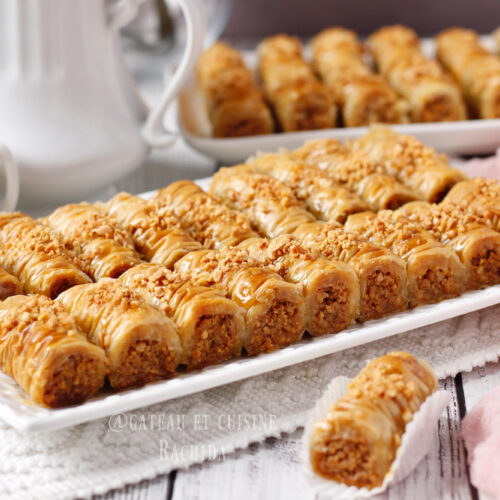
INGREDIENTS
- 500 g almonds 17.6 oz
- 1 teaspoon cinnamon
- 4 tablespoons orange blossom water more or less depending on consistency
- 1 teaspoon honey
- 2 packages of phyllo dough 470 g each, the ones I used (16.6 oz per package). You will have leftover dough; see the tips above. I used 16 sheets.
- 400 g melted and clarified butter 14 oz
- 480 g honey 17 oz
PREPARATION
- See the tips in the article to adjust the quantities and visualize the steps with images.
Blanching the almonds
- Cover the almonds with water and bring to a boil until the skin easily comes off. Don't boil them too long.
- Pour them into a colander and peel them. To make it easier, you can wrap them in a clean cloth and rub between your hands. Do this the day before or a few hours before toasting them.
- Toast the almonds in hot oil over medium heat and let them cool before grinding them into fairly fine grains.
- In a large bowl, mix the crushed almonds with cinnamon, honey, and orange blossom water.
Preparing the baklavas
- Melt the butter and clarify it, which means letting it rest a bit after removing the foam until the milk settles at the bottom, then pour only the butter into another saucepan.
- Carefully unroll the filo pastry sheets on a clean cloth and remove 2 at a time. Roll the rest in their plastic and in a clean towel to prevent them from drying out during preparation.
- Place a sheet of filo pastry on the work surface and brush it with a little butter. Place the 2nd sheet on top and brush it with butter as well, as you can see in the image below.
- Place the slightly longer stick about 11 cm / 4.3 inch from the edge, widthwise, then fold the phyllo dough over it. Brush with a little butter.
- Put some almonds evenly on this border, against the stick, leaving 1 cm / 0.4 inches empty on each side (see step image).
- Roll gently, tightening well around without pressing on the pastry.
- Slightly crumple the formed filo pastry roll by gently pushing both ends towards the center to create the pleated effect.
- Hold it this way with your hands and place it in the mold, preferably with the same width as the roll to keep the pleated effect (26 cm / 10.2 inches for me).
- Gently remove the stick by pushing the roll into the mold.
- Repeat until you run out of sheets and filling.
- Cut each roll into identical sized pieces, according to your preference (usually 4 to 5 pieces per roll).
- Brush the entire surface well with melted butter.
Baking
- Bake at 180°C (356°F) with static heat for about 40 minutes, until the baklava is golden brown. Check from time to time towards the end.
- Meanwhile, gently heat the honey to liquefy it. If it's already liquid, this isn't necessary. It should be poured cold over the hot baklava.
- As soon as it comes out of the oven, drizzle the hot baklava with honey to soak it well.
- Decorate the top of each baklava, in the center, with some crushed almond set aside from the filling, or by adding a bit more, as I did.
- Let it absorb for at least 6 hours, ideally overnight.
- After this time, run a knife between each baklava before removing them and placing them in paper cases.